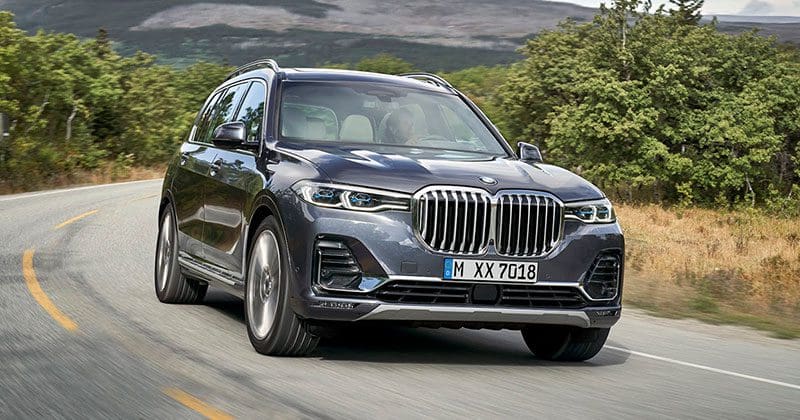Americans cannot get enough of full-size, three-row SUVs. BMW had a problem until this model year – they didn’t have one to offer the public. The best they could muster was an X5 with an optional small third row. But now BMW has entered this crowded market with its X7. Although it is not as big as the current leader of the pack, the Lincoln Navigator, it makes its case as a premium luxury SUV with a pedigree and nameplate that will impress the neighbors and remain relevant for years to come.
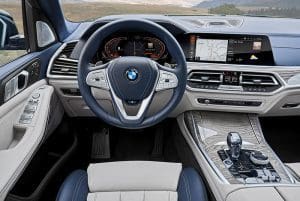 When you enter the cockpit of the X7, you are greeted with both a 12.3-inch touchscreen angled toward the driver and a 12.3-inch instrument cluster. The graphics in the instrument cluster mimic an analog BMW cluster but with a modern touch. You know once you get in and start to press the buttons that you have entered something with Germanic build quality. Together in the center console are the iDrive Controller, the newly designed crystal gear selector, the start/stop button, the Driving Experience Control switches, electronic parking brake switch and controls governing the settings for the air suspension and optional off-road modes. The control panel for the standard four-zone climate control system also has a new modern design. And to get back to that gear selector that is made of crystal – it is as beautiful as the one Volvo created for its special X90 made by Orrefors. No word if Nachtmann makes it for BMW. The only niggle I have is that BMW insists on having the shifter work counterintuitively to what US customers are accustomed to. To place the vehicle in park, you have to press a small button labeled P on the shifter. We would prefer a more traditional mechanical detent in the action of the movement.
When you enter the cockpit of the X7, you are greeted with both a 12.3-inch touchscreen angled toward the driver and a 12.3-inch instrument cluster. The graphics in the instrument cluster mimic an analog BMW cluster but with a modern touch. You know once you get in and start to press the buttons that you have entered something with Germanic build quality. Together in the center console are the iDrive Controller, the newly designed crystal gear selector, the start/stop button, the Driving Experience Control switches, electronic parking brake switch and controls governing the settings for the air suspension and optional off-road modes. The control panel for the standard four-zone climate control system also has a new modern design. And to get back to that gear selector that is made of crystal – it is as beautiful as the one Volvo created for its special X90 made by Orrefors. No word if Nachtmann makes it for BMW. The only niggle I have is that BMW insists on having the shifter work counterintuitively to what US customers are accustomed to. To place the vehicle in park, you have to press a small button labeled P on the shifter. We would prefer a more traditional mechanical detent in the action of the movement.
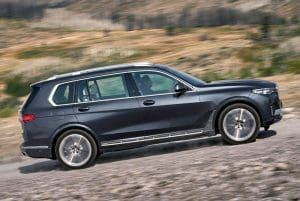 The engine of my tester was the 3.0-liter twin-turbo powerplant that moves this large vehicle to 60 mph in just 5.8 seconds. With the efficiency of the newly designed eight-speed transmission, I achieved fuel economy numbers above 20 mpg doing highway duty! That is impressive for a vehicle armed with four-wheel drive capability that even allows the user to lock the rear differential to get out of deep mud or snow. According to BMW, the locking effect is produced by means of an electric motor and allows as much as 1,106 lb-ft of drive torque to be redirected from the wheel with less grip to the wheel with more grip.
The engine of my tester was the 3.0-liter twin-turbo powerplant that moves this large vehicle to 60 mph in just 5.8 seconds. With the efficiency of the newly designed eight-speed transmission, I achieved fuel economy numbers above 20 mpg doing highway duty! That is impressive for a vehicle armed with four-wheel drive capability that even allows the user to lock the rear differential to get out of deep mud or snow. According to BMW, the locking effect is produced by means of an electric motor and allows as much as 1,106 lb-ft of drive torque to be redirected from the wheel with less grip to the wheel with more grip.
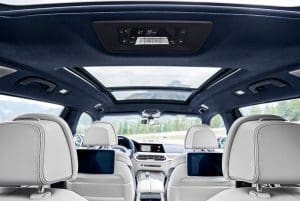 Probably the best parlor trick of the X7 is the motorized second- and third-row rear seats. When I first tried them and pressed the button for the second row, nothing happened. I then walked around the car to the second row and, lo and behold, it was mysteriously tucked away. It takes some time for the motorization to happen because the BMW does everything for you, including first stowing the headrest in a position that keeps it from rubbing against the front seat. The backrests of the second- and third-row seats can also be adjusted – and the second-row seats moved fore and aft – from the cargo area. When the third-row seats are not in use, the new BMW X7 offers 48.6 cubic feet of load capacity.
Probably the best parlor trick of the X7 is the motorized second- and third-row rear seats. When I first tried them and pressed the button for the second row, nothing happened. I then walked around the car to the second row and, lo and behold, it was mysteriously tucked away. It takes some time for the motorization to happen because the BMW does everything for you, including first stowing the headrest in a position that keeps it from rubbing against the front seat. The backrests of the second- and third-row seats can also be adjusted – and the second-row seats moved fore and aft – from the cargo area. When the third-row seats are not in use, the new BMW X7 offers 48.6 cubic feet of load capacity.
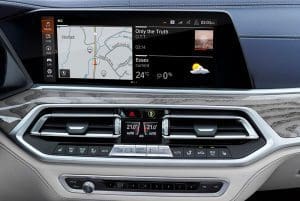 Another cool feature for those with tight driveways is BMW Backup Assist. Essentially, the X7’s steering becomes a DVR and records the exact steering wheel inputs from the last 150 feet. You no longer need to contort your head to uncomfortable positions to negotiate your driveway. All the driver has to do is operate the accelerator and brakes and monitor the surrounding area. The system is initiated by pressing a button when the vehicle is stationary and the gear selector is in the “P” position. The steering movements made during the vehicle’s last forward maneuver are stored by the system and retained. This means the Back-Up Assistant can be used to maneuver the new BMW X7 backwards out of a parking position that it drove into forwards the previous day. We are not quite there yet, but when steering-by-wire becomes more commonplace, this is something that can be added by the aftermarket.
Another cool feature for those with tight driveways is BMW Backup Assist. Essentially, the X7’s steering becomes a DVR and records the exact steering wheel inputs from the last 150 feet. You no longer need to contort your head to uncomfortable positions to negotiate your driveway. All the driver has to do is operate the accelerator and brakes and monitor the surrounding area. The system is initiated by pressing a button when the vehicle is stationary and the gear selector is in the “P” position. The steering movements made during the vehicle’s last forward maneuver are stored by the system and retained. This means the Back-Up Assistant can be used to maneuver the new BMW X7 backwards out of a parking position that it drove into forwards the previous day. We are not quite there yet, but when steering-by-wire becomes more commonplace, this is something that can be added by the aftermarket.
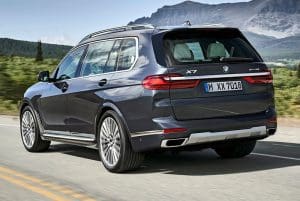 One last technology that is available in the aftermarket can be a godsend for those who lose their keys. The BMW Digital Key employs Near Field Communication (NFC) technology to allow the new BMW X7 to be locked and unlocked from a compatible smartphone, removing the need for a conventional car key. Holding the smartphone up to the door handle opens the car. Once inside, the engine can be started as soon as the phone has been placed in the wireless charging or smartphone tray. The BMW Digital Key is compatible with all NFC-capable Samsung Galaxy smartphones running Android 8.0 and above.
One last technology that is available in the aftermarket can be a godsend for those who lose their keys. The BMW Digital Key employs Near Field Communication (NFC) technology to allow the new BMW X7 to be locked and unlocked from a compatible smartphone, removing the need for a conventional car key. Holding the smartphone up to the door handle opens the car. Once inside, the engine can be started as soon as the phone has been placed in the wireless charging or smartphone tray. The BMW Digital Key is compatible with all NFC-capable Samsung Galaxy smartphones running Android 8.0 and above.
The X7 is BMW’s answer to the full-size SUV calling. The technology available is impressive. It is worth a serious look if you are also interested in the Navigator, Escalade, Q7 or GLS models.
